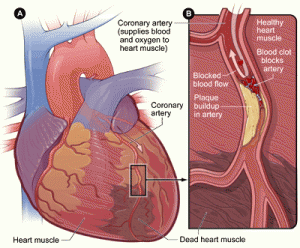Heart disease is no longer a male dominated affliction. Today in Canada 50.5% of heart attack victims are woman, making it an equal opportunity catastrophe. What’s worse is, according to the Heart and Stroke Foundation of Canada, a woman is 16% more likely to die during a heart attack than a man. The number one killer of women today is heart disease and stroke.
A heart attack occurs “when the blood supply to the heart is slowed or stopped because of a blockage…. A heart attack may also occur when a coronary artery temporarily contracts or goes into a severe spasm, effectively shutting off the flow of blood to the heart. The length of time the blood supply is cut off will determine the amount of damage to the heart.” (Heart and Stroke Foundation of Canada, 2009) In 90% of cases, a heart attack due to a blockage is attributed to a condition called Atherosclerosis. This is caused when a build-up of plaque in the arteries causes them to narrow significantly.
There are many factors associated with a person’s risk of developing heart disease and experiencing a heart attack. Some are unique to women, some affect everyone, some you can control and some you can’t. Women who have entered menopause have a much greater chance of suffering a heart attack. This is because the hormone, estrogen, has a protective effect on a woman’s cardiovascular system during her childbearing years. Anyone with high levels of HDL cholesterol – the bad cholesterol – and /or low levels of LDL – the good cholesterol – is at an increased risk for developing any aspect of heart disease. This also holds true for anyone with an elevated level of triglycerides (a form of fat in the blood) and anyone with high blood pressure. A person with diabetes has a greater risk of sustaining a heart attack. Anyone who is overweight or obese has also increased their risk, especially if their weight in carried mainly around their abdomen, in an apple shape. This is because the extra weight puts pressure and constriction on important internal structures like organs and blood vessels. Consuming excessive amounts of alcohol raises your risk. For a woman, more than one or two drinks a day and more than nine drinks a week constitutes an excessive amount. A large contributing factor to a person’s risk of having a heart attack is physical inactivity. The Canadian government recommends at least 60 minutes of physical activity everyday. Smoking is a big problem if you want to remain heart attack free. One of the leading theories as to why the number of women having heart attacks is on the rise directly relates this increase to the increase of female smokers. The amount of stress a person feels on a daily basis impacts their chances for having a heart attack. Stress is categorized as a controllable risk factor. If you are experiencing a high level of stress you need to either find a way to eliminate those stressors or develop skills to help you better cope with the things that stress you out. There are only four potential risk factors that are out of your control; the older you are the more likely you are to have a heart attack; women have a higher risk than men; anyone with a family history of an immediate family member developing heart disease before the age of 55 or before menopause has an increased risk; and people of Native American, African or south Asian descent have a greater risk of developing diabetes and high blood pressure, which both raise the risk of an impending heart attack.
Signs and symptoms of a heart attack do not discriminate. Though women may feel or describe it in a different way, we will feel pain or discomfort in the same places as a man. Someone who is in the midst of a heart attack can feel pain or discomfort in their chest, throat, neck, jaw, should, arm or back. This pain will come on sudden, and will not go away with rest. It has been described as feeling like burning, squeezing, heaviness, tightness or pressure. Other symptoms include: shortness of breath, sweating, nausea, indigestion-like sensations, clammy skin or feelings of anxiety, fear or impending doom. Some signs of a heart attack can only be observed in the victim by others. These include: sudden unresponsiveness, especially when called or touched and not breathing when you tilt their head back and check for at least five seconds. One person will rarely display every symptom on the list and women are more likely than men to deny that they could be having a heart attack, making it of utmost importance to seek medical attention if you are experiencing any of these symptoms.
Heart disease can affect any person, at any age. Prompt recognition of symptoms and immediate action can greatly improve your ability to survive a heart attack.

